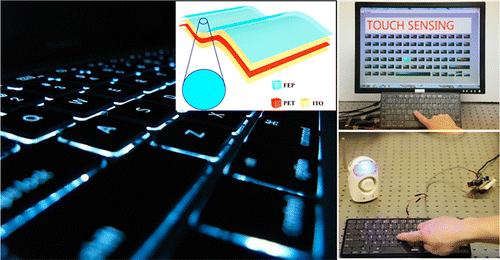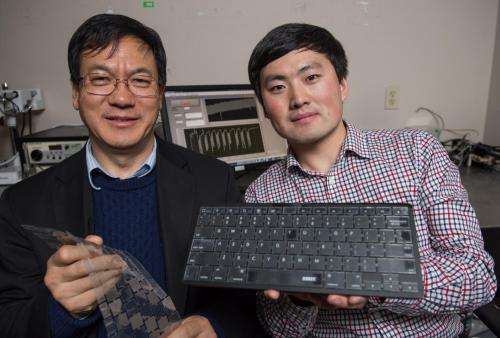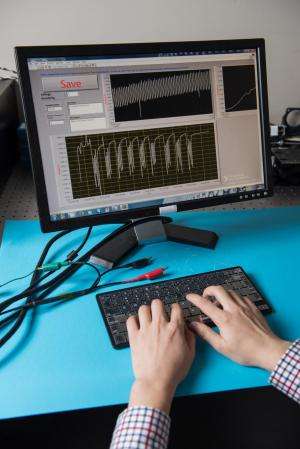Smart keyboard cleans and powers itself—and can tell who you are (Update)

By analyzing such parameters as the force applied by key presses and the time interval between them, a new self-powered non-mechanical intelligent keyboard could provide a stronger layer of security for computer users. The self-powered device generates electricity when a user's fingertips contact the multi-layer plastic materials that make up the device.
"This intelligent keyboard changes the traditional way in which a keyboard is used for information input," said Zhong Lin Wang, a Regents professor in the School of Materials Science and Engineering at the Georgia Institute of Technology. "Every punch of the keys produces a complex electrical signal that can be recorded and analyzed."
Conventional keyboards record when a keystroke makes a mechanical contact, indicating the press of a specific key. The intelligent keyboard records each letter touched, but also captures information about the amount of force applied to the key and the length of time between one keystroke and the next. Such typing style is unique to individuals, and so could provide a new biometric for securing computers from unauthorized use.
In addition to providing a small electrical current for registering the key presses, the new keyboard could also generate enough electricity to charge a small portable electronic device or power a transmitter to make the keyboard wireless.
An effect known as contact electrification generates current when the user's fingertips touch a plastic material on which a layer of electrode material has been coated. Voltage is generated through the triboelectric and electrostatic induction effects. Using the triboelectric effect, a small charge can be produced whenever materials are brought into contact and then moved apart.
"Our skin is dielectric and we have electrostatic charges in our fingers," Wang noted. "Anything we touch can become charged."
While the self-powered feature could provide a convenience benefit and potentially eliminate the need for batteries in wireless keyboards, Wang believes the major impact of the device may be in helping to secure computers by using individual typing patterns or habits as a biometric.

"This has the potential to be a new means for identifying users," he said. "With this system, a compromised password would not allow a cyber-criminal onto the computer. The way each person types even a few words is individual and unique."
To evaluate the authentication potential of the keyboard, the research team asked 104 persons to type the word "touch" four times, and recorded the electrical patterns produced. Using signal analysis techniques, they were able to differentiate individual typing patterns with low error rates, Wang said.
Instead of individual mechanical keys as in traditional keyboards, Wang's intelligent keyboard is made up of vertically-stacked transparent film materials. Researchers begin with a layer of polyethylene terephthalate between two layers of indium tin oxide (ITO) that form top and bottom electrodes.
Next, a layer of fluorinated ethylene propylene (FEP) is applied onto the ITO surface to serve as an electrification layer that generates triboelectric charges when touched by fingertips. FEP nanowire arrays are formed on the exposed FEP surface through reactive ion etching.
The keyboard's operation is based on coupling between contact electrification and electrostatic induction, rather than the traditional mechanical switching. When a finger contacts the FEP, charge is transferred at the contact interface, injecting electrons from the skin into the material and creating a positive charge.

When the finger moves away, the negative charges on the FEP side induces positive charges on the top electrode, and equal amounts of negative charges on the bottom electrode. Consecutive keystrokes produce a periodic electrical field that drives reciprocating flows of electrons between the electrodes. Though eventually dissipating, the charges remain on the FEP surface for an extended period of time.
Wang believes the new smart keyboard will be competitive with existing keyboards, in both cost and durability. The new device is based on inexpensive materials that are widely used in the electronics industry.
As part of the study, his research group evaluated the keyboard under challenging conditions, including application of moisture, dirt and oil. "You could pour coffee on the keyboard, and it would not be damaged," said Wang. "Because it is based on a sheet of plastic, liquids will not hurt it."
More information: "Personalized Keystroke Dynamics for Self-Powered Human-Machine Interfacing" ACS Nano, Article ASAP. DOI: 10.1021/nn506832w
Abstract
The computer keyboard is one of the most common, reliable, accessible, and effective tools used for human–machine interfacing and information exchange. Although keyboards have been used for hundreds of years for advancing human civilization, studying human behavior by keystroke dynamics using smart keyboards remains a great challenge. Here we report a self-powered, non-mechanical-punching keyboard enabled by contact electrification between human fingers and keys, which converts mechanical stimuli applied to the keyboard into local electronic signals without applying an external power. The intelligent keyboard (IKB) can not only sensitively trigger a wireless alarm system once gentle finger tapping occurs but also trace and record typed content by detecting both the dynamic time intervals between and during the inputting of letters and the force used for each typing action. Such features hold promise for its use as a smart security system that can realize detection, alert, recording, and identification. Moreover, the IKB is able to identify personal characteristics from different individuals, assisted by the behavioral biometric of keystroke dynamics. Furthermore, the IKB can effectively harness typing motions for electricity to charge commercial electronics at arbitrary typing speeds greater than 100 characters per min. Given the above features, the IKB can be potentially applied not only to self-powered electronics but also to artificial intelligence, cyber security, and computer or network access control.
Journal information: ACS Nano
Provided by American Chemical Society



















